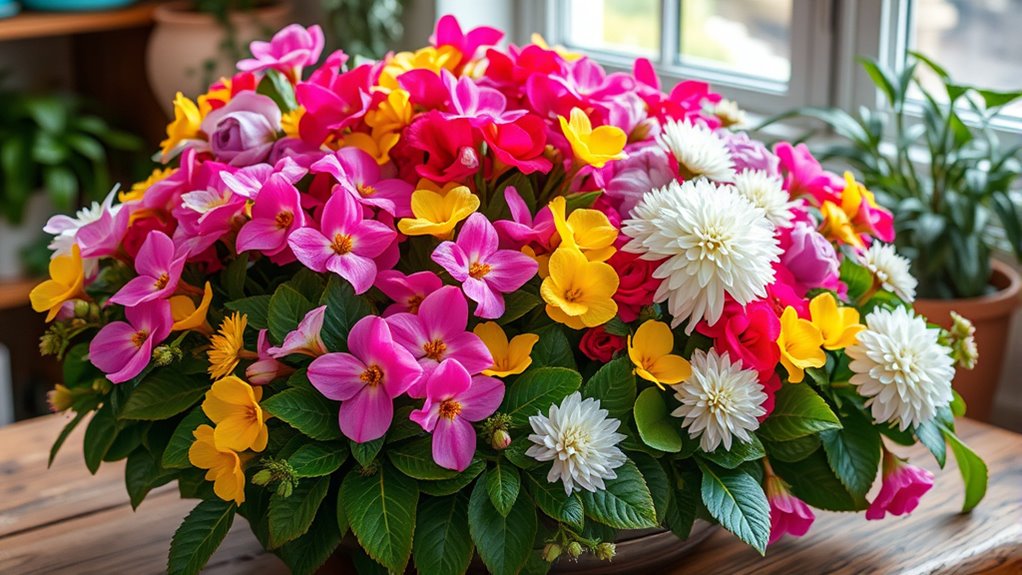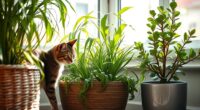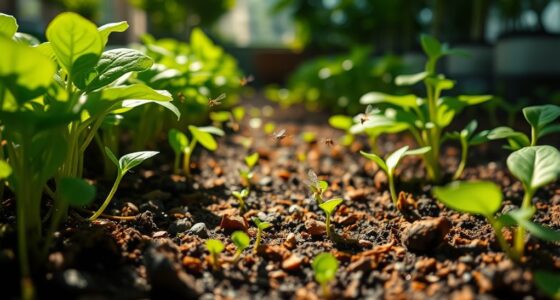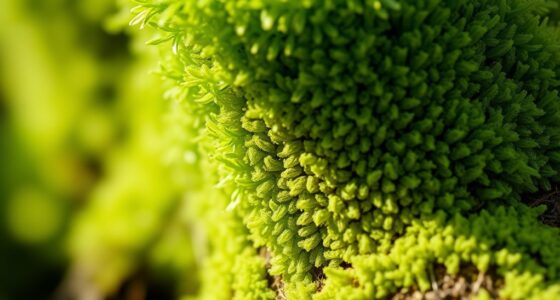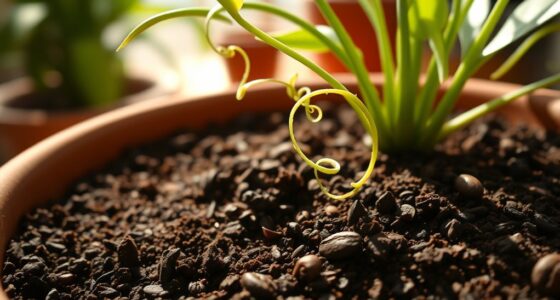For vibrant indoor plants, consider Anthurium, Kalanchoe, and African Violets. These flowering beauties not only brighten your space but also vary in care levels, making them suitable for different home environments. If you want low-maintenance options, Lipstick Plants and Rieger Begonias are great choices. If your space gets lots of light, go for Kalanchoe. Want to learn more about selecting and caring for indoor flowering plants? There’s plenty of helpful information ahead!
Key Takeaways
- Anthurium: Known for its long-lasting flowers and glossy leaves, making it a vibrant choice for indoor décor.
- Kalanchoe: A low-maintenance succulent with bright blooms, perfect for beginners.
- African Violets: Thrive in bright, indirect light and produce colorful flowers throughout the year.
- Peace Lily: Features elegant white flowers and also purifies the air, enhancing indoor environments.
- Rieger Begonias: Ideal for less sunny spots, they flourish in bright, indirect light with minimal care required.
Popular Indoor Flowering Plants
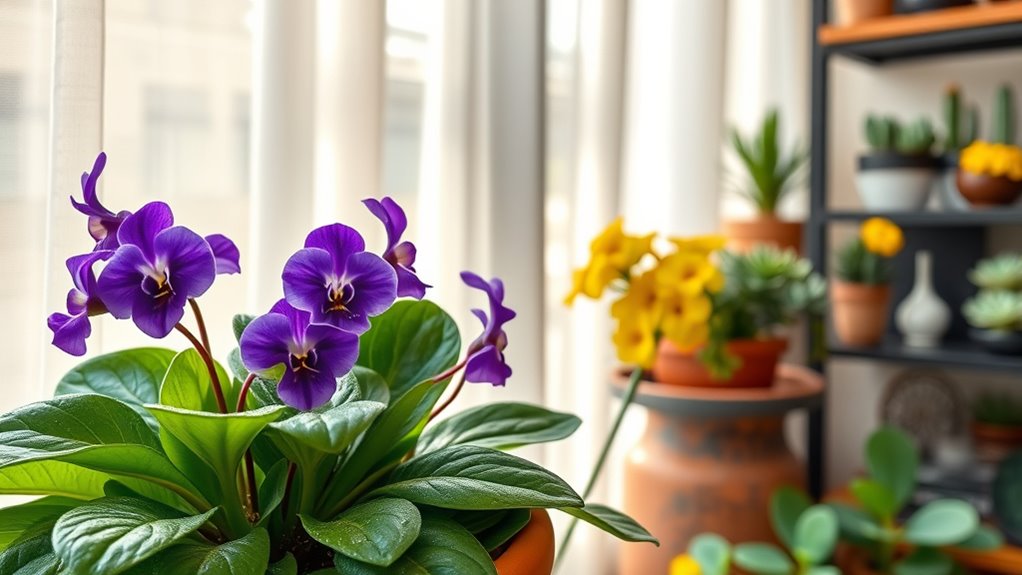
When you’re looking to brighten up your indoor space, popular flowering plants like the Peace Lily and African Violet can make a stunning addition. The Peace Lily not only showcases elegant white flowers but also purifies the air, enhancing your living environment, and it is known to improve indoor air quality through its filtration capabilities. Additionally, studies have shown that certain plants, including the Peace Lily, can help reduce stress levels in indoor settings. African Violets stand out with their colorful blooms, thriving in bright, indirect light, making them easy to care for. If you’re in the mood for something vibrant, consider the Kalanchoe, a succulent that boasts a variety of colorful flowers and minimal care requirements. For a touch of elegance, the Anthurium offers long-lasting flowers and glossy leaves, while the Bromeliad features exotic blooms that thrive in bright areas without direct sunlight. These options will surely bring life to your home, as many of them can bloom year-round with proper care!
Low-Maintenance Flowering Options
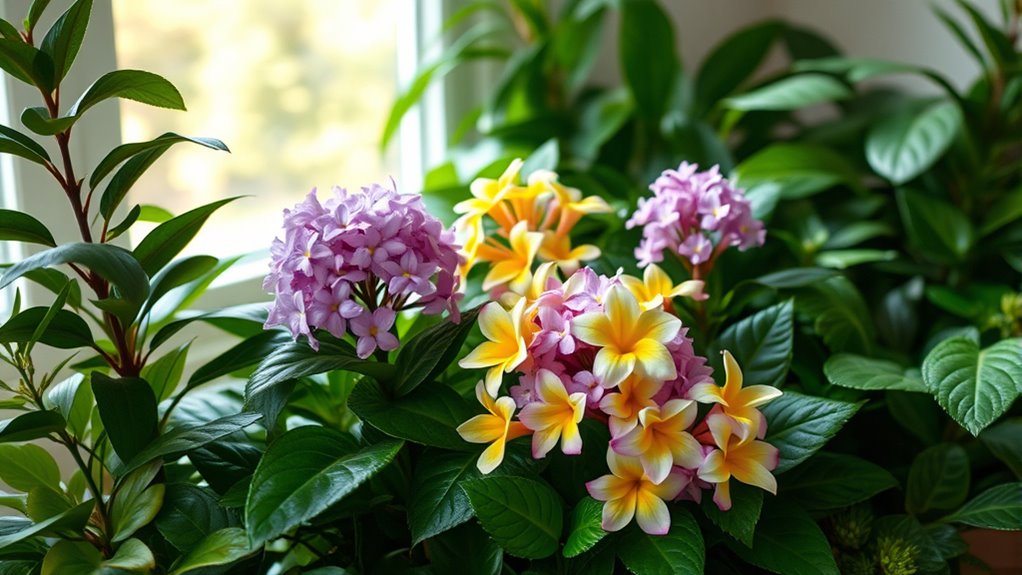
If you want to enjoy vibrant blooms without the hassle of intensive care, low-maintenance flowering options are perfect for you. African violets bring year-round color with minimal effort, thriving in bright, indirect light. Indoor blooming plants provide an array of options for colorful displays throughout the year. Peace lilies offer elegant white blooms and excel in low to medium light. If you love seasonal excitement, holiday cacti bloom beautifully around the holidays and prefer similar lighting. Kalanchoe is a succulent that provides long-lasting, vibrant flowers with little care. Bromeliads are another easy choice, showcasing striking foliage and occasional blooms. Most of these plants need their soil to dry slightly between waterings and thrive in average household temperatures, making them ideal companions for busy lifestyles. Enjoy the beauty without the stress!
Best Plants for Bright Light Conditions

For those seeking to brighten up their indoor spaces, selecting the right plants can make all the difference. Bright light plants thrive in direct or indirect sunlight for at least six hours daily.
Consider the Fiddle-Leaf Fig for its stunning leaves, or the Areca Palm, which loves consistent moisture. The Hibiscus adds vibrant blooms, while Jasmine offers delightful fragrance. The Yucca Plant is perfect for those who prefer low watering. Additionally, rubber plants thrive in bright light and are ideal for beginners, adding a lush look to spaces. Effective wall organization can create a visually appealing backdrop for your indoor garden. It’s essential to monitor soil moisture levels, as proper watering will contribute to the overall health and vibrancy of your plants. Incorporating self-watering planters can further simplify the care routine while ensuring optimal hydration for your greenery.
Position these plants near south or west-facing windows for optimal growth. Remember to use well-draining soil and prune regularly. Keep an eye out for pests and ensure you don’t overwater.
With the right care, these plants will enhance your home’s ambiance and air quality beautifully.
Ideal Plants for Cooler Rooms
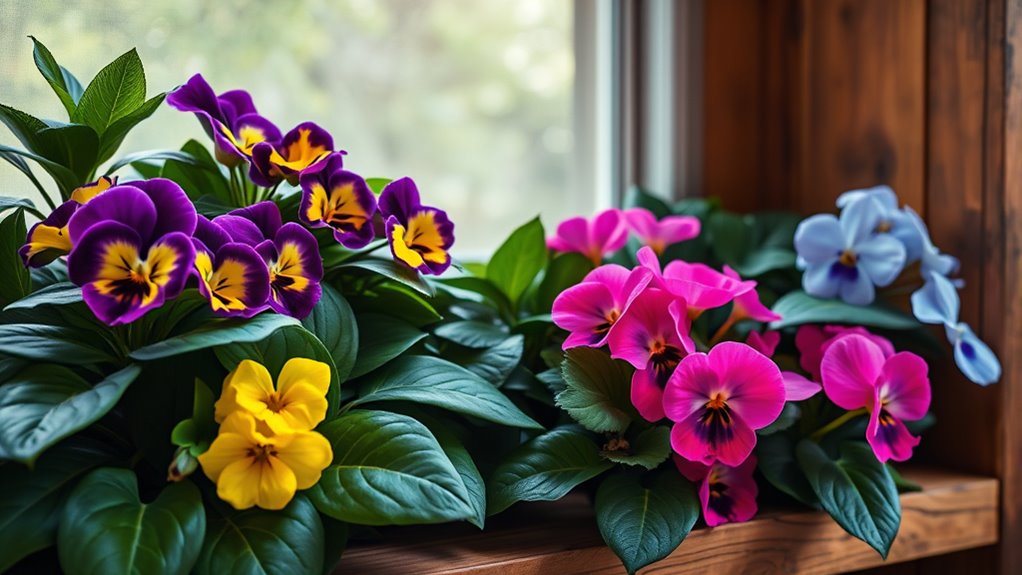
While cooler rooms might seem challenging for plant enthusiasts, several resilient indoor plants can thrive in these conditions.
Consider the jade plant, which can survive down to 32°F (0°C) and needs infrequent watering. The cast iron plant is another great choice; it tolerates low light and cold temperatures effortlessly. Some plants may not thrive but can survive in lower temperatures, making them suitable for cooler environments. Additionally, many of these plants are known for their air purification abilities, enhancing the overall atmosphere of your space. Floral arrangements can be beautifully complemented by the presence of these hardy plants. Chia seeds, known for their high fiber content, can also support your overall wellness as you care for your indoor plants.
If you want something hardier, the sago palm withstands temperatures as low as 15°F (-9°C), although its growth may slow. Dracaena marginata and geraniums also tolerate cooler climates while requiring minimal care.
Additionally, plants like the ZZ plant and snake plant purify the air and flourish in low light. These options not only enhance your room’s aesthetic but also improve air quality, making them ideal for cooler spaces.
Fragrant Indoor Flower Options
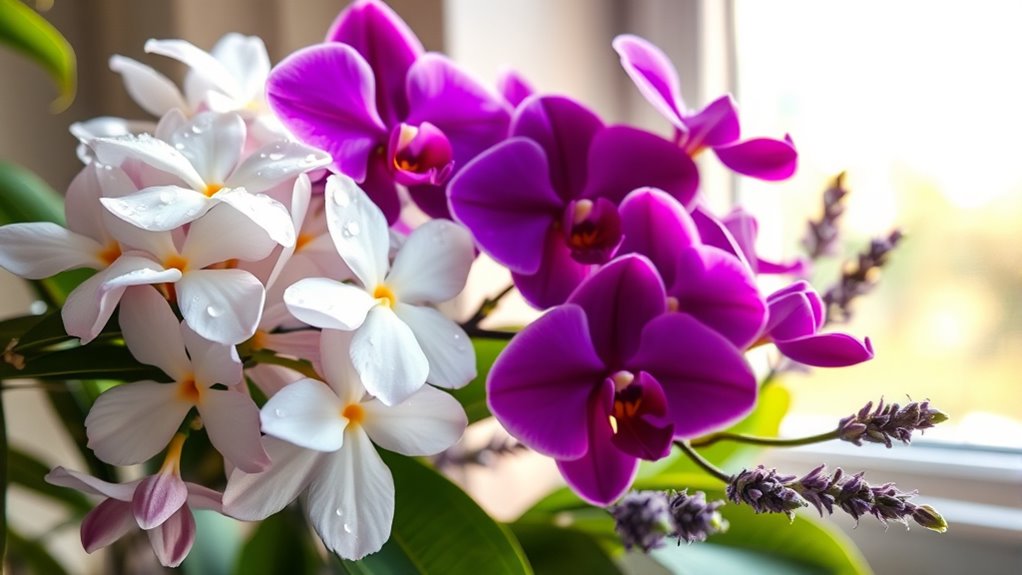
Transforming your indoor space into a fragrant oasis can be as simple as choosing the right flowers. Start with jasmine for its sweet, intoxicating scent, or opt for gardenias, known for their creamy blooms and lasting aroma. Gardenias produce a strong, permeating scent throughout the house, enhancing the overall ambiance. Hoya offers delicate, waxy flowers with a subtle perfume, while citrus flowers from Meyer lemon trees fill your home with a fresh fragrance. For something easy to grow, consider scented pelargoniums, which release delightful scents when you rub their leaves. Additionally, engaging in the creative process of maintaining these plants can enhance your overall well-being, as home improvement can significantly impact the quality of life for the elderly. Incorporating nutrient-dense plants like these can contribute positively to your indoor environment. Paper-white narcissi create a lovely winter fragrance, and jasmine polyanthum thrives in cooler rooms. With these options, you can enjoy a variety of delightful aromas year-round, making your indoor environment truly inviting.
Long-Lasting Blooming Plants
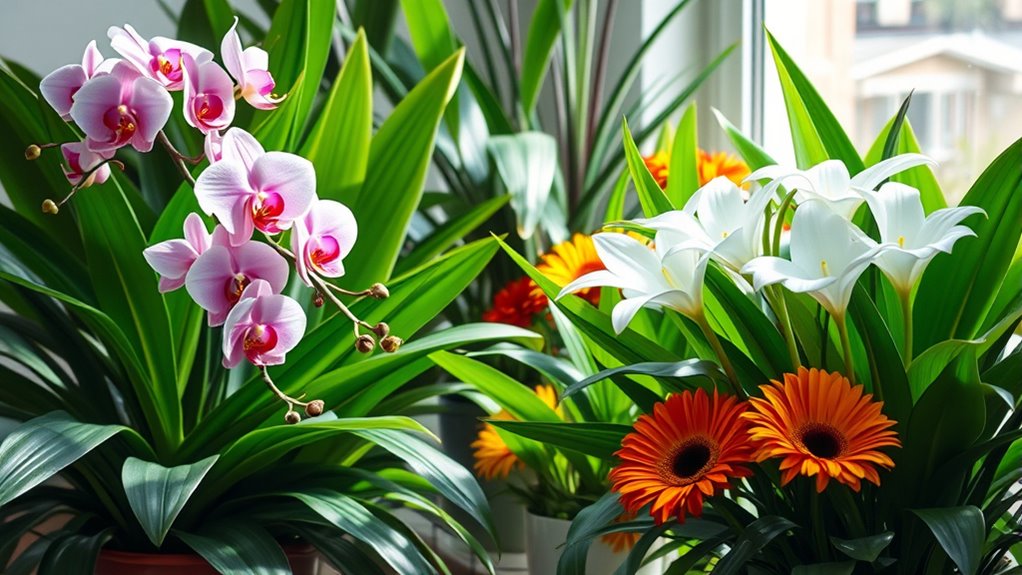
If you’re looking to add vibrant color and life to your indoor space, long-lasting blooming plants are an excellent choice. Consider the Cape Primrose for its orchid-like flowers that bloom for up to 10 months. The elegant Peace Lily thrives in low light and purifies the air while producing stunning white blooms. Additionally, it is known for its air-purifying qualities, making it a great option for bedrooms, as it can help improve overall air quality. The popularity of clean beauty extends to indoor plants as well, promoting the idea of using nature to enhance our living spaces.
African Violets offer year-round color in shades of purple and pink, while Phalaenopsis orchids can last for over three months with proper care. For a pop of color, try the Anthurium, which showcases bright spathes in multiple hues. Kalanchoe and Lipstick Plants also provide vibrant blooms, making them perfect low-maintenance options. These plants will keep your home lively and beautiful throughout the year.
Tips for Caring for Indoor Flowering Plants
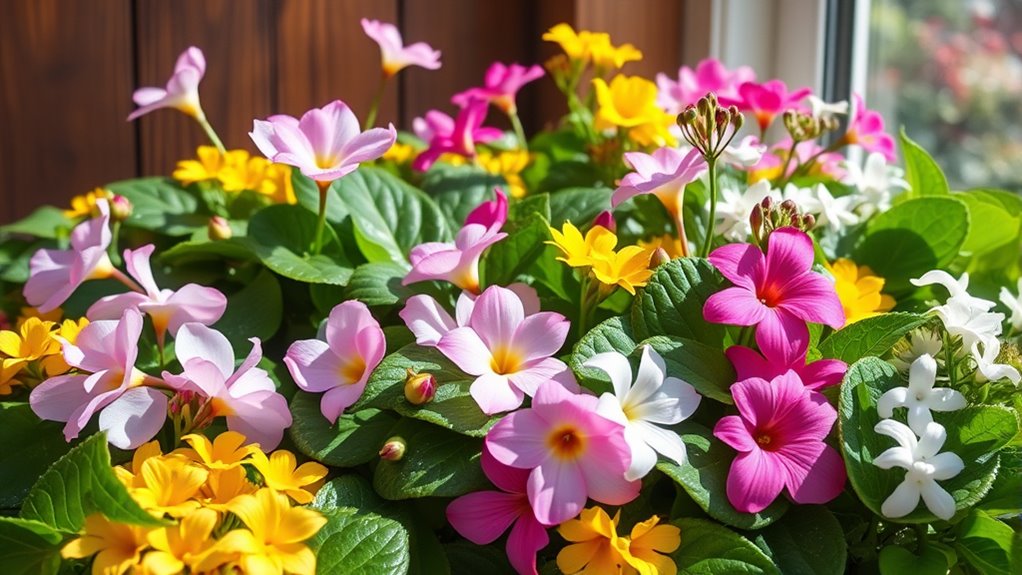
Long-lasting blooming plants can brighten your indoor space, but keeping them thriving requires some care.
First, pay attention to lighting; ensure bright light plants like Kalanchoe and Hibiscus get direct sunlight, while African Violets prefer bright, indirect light. Rieger Begonias thrive in bright, indirect light, making them a great choice for less sunny spots in your home. Choosing the right plants can also enhance your daily routines and contribute positively to your lifestyle. Consider using unique and wicked planters to showcase your flowers creatively. Additionally, using durable materials for your planters can help ensure they last longer in various indoor environments.
For watering, check soil moisture and water from the bottom for plants like Cyclamen to prevent leaf spotting.
Maintain consistent temperatures, ideally between 60–75°F, and avoid extreme conditions.
Fertilize with balanced or specialized formulas every few weeks during the growing season, but be cautious not to overfertilize.
Regularly prune spent flowers and dead leaves to encourage growth, and keep an eye out for pests.
Dusting leaves helps maintain their health and appearance, ensuring your plants continue to thrive beautifully.
Frequently Asked Questions
How Do I Propagate Indoor Flowering Plants?
To propagate indoor flowering plants, you can try several methods.
For water propagation, take cuttings and place them in water until roots form.
Soil propagation works great too; just plant cuttings in moist soil. If you’re using leaf cuttings, ensure they’re from a healthy plant.
For clump-forming plants, division is the way to go.
Always keep your cuttings in a warm, humid environment with indirect light for the best results.
Which Indoor Flowering Plants Are Safe for Pets?
Imagine your curious cat batting at a colorful flower, but you don’t want to worry.
For pet-safe indoor flowers, consider African Violets, Gloxinia, and Orchids.
They’re not just beautiful; they create a vibrant sanctuary in your home. Their bright colors can lift your spirits without risking your pet’s safety.
Can Indoor Flowering Plants Improve Air Quality?
Absolutely, indoor flowering plants can improve air quality!
They actively filter out pollutants like formaldehyde, benzene, and ammonia, making your space healthier. By incorporating plants like peace lilies and gerbera daisies, you not only enhance your environment’s aesthetic but also contribute to cleaner air.
Just keep in mind their light and watering needs to thrive. With a bit of care, you’ll enjoy both beauty and fresher air in your home!
What Are the Signs of Overwatering?
If you’re wondering about the signs of overwatering, keep an eye out for yellowing or wilting leaves.
You might notice leaves falling off, and even moldy spots on stems or leaves.
Check for brown tips or a foul odor, which could indicate root rot.
If your plant feels unstable with mushy bases, it’s definitely time to reassess your watering routine and adjust accordingly to save your plant from further damage.
How Often Should I Fertilize Indoor Flowering Plants?
You should fertilize your indoor flowering plants every 2-4 weeks during spring and summer when they’re actively growing.
In fall and winter, cut back or stop fertilizing as they enter their dormant phase.
Choose a balanced fertilizer, and always moisten the soil before application to avoid root burn.
Keep an eye on your plants; if you notice yellowing leaves or weak growth, it might be time to adjust your fertilization routine.
Conclusion
Incorporating flowering indoor plants can transform your space into a vibrant oasis. Imagine walking into a room filled with the sweet scent of blooms, instantly lifting your spirits. Whether you choose low-maintenance options or fragrant varieties, there’s a perfect plant waiting for you. By following the care tips provided, you can enjoy stunning flowers year-round. So, why not bring a touch of nature indoors and watch your home come alive with color and fragrance?

